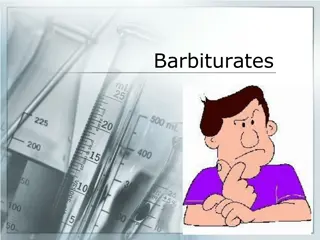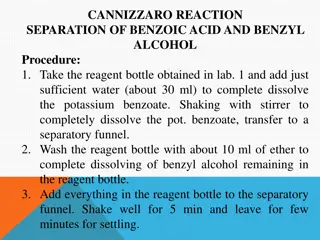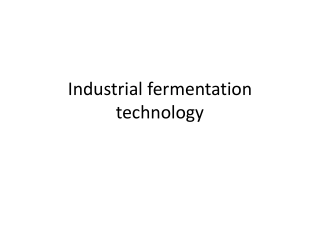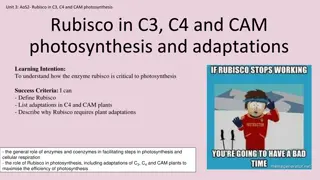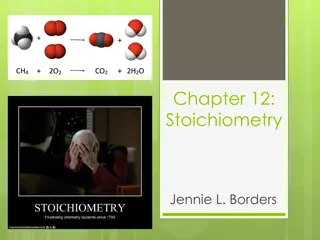Aldol Condensation Reaction: Preparation of Chalcones
Chalcones are important unsaturated aromatic ketones that serve as biogenetic precursors of flavonoids and isoflavonoids. They have various medicinal and pharmaceutical applications due to their biological activities. Chalcones are easily synthesized compounds with potential therapeutic uses, making them of great interest to researchers. The Aldol condensation reaction plays a key role in preparing chalcones, allowing the formation of new -hydroxy carbonyl compounds. This reaction can be conducted under acidic or basic conditions, leading to the synthesis of diverse chalcone derivatives.
Download Presentation
Please find below an Image/Link to download the presentation.
The content on the website is provided AS IS for your information and personal use only. It may not be sold, licensed, or shared on other websites without obtaining consent from the author. Download presentation by click this link. If you encounter any issues during the download, it is possible that the publisher has removed the file from their server.
Presentation Transcript
The Aldol Condensation Reaction Preparation of Benzalacetophenon (Chalcones) by Msc. Hussien Ali Karim Department of Pharmaceutical Chemistry/Collage of pharmacy 4 4th th stage: stage: 2 2nd ndlab. lab. 1
Chalcones Chalcones are , unsaturated aromatic ketones containing the reactive keto ethylene CH=CH-. Many of the chalcones are highly biological which have medicinal pharmaceutical applications group CO active and 2
Chalcones are the biogenetic precursors of flavonoids and isoflavonoids, which are abundant in plants is an open-chain flavonoid with , -unsaturated carbonyl group and is one of the important compound groups of flavonoid derived from nature and synthetic compounds belonging to the flavonoid family which remain a fascination among researchers in the 21st century due to their simple chemistry, ease of synthesis, large number of replaceable hydrogens to yield a variety of derivatives. Due to their abundance in plants and ease of synthesis, this class of compounds has generated great interest for possible therapeutic uses . Thousands of chalcone derivatives are synthesized in chemical laboratories, up to date. 3
The alternative name given to chalcone are phenyl styryl ketone, benzalacetophenone, -phenylacrylophenone, -oxo- , - diphenyl- -propylene and -phenyl- -benzoylethylene. Chalcones containing several functional groups showed a wide spectrum of biological activities such as antimicrobial, anti- malarial, anticancer, anti-inflammatory, antiprotozoal , anti-HIV ,antioxidant and antiulcer activities. Chalcones and their derivatives have also been found to display antioxidant, antimicrobial , anticancer, anti-malarial, anti-inflammatory , antiulcer , antileishmanial and anti-HIVproperties. 4
Chalcones are well soluble in alcohols , aqueous acidic and alkaline solutions, as well as in organic solvents, such as acetone, chloroform and dichloromethane. In alkaline solutions, they exhibit deep red or orange red colors. All chalcones are positive to Wilson test, i.e., pink colorization with conc. H2SO4. Also, chalcones treated with alcoholic ferric chloride solution resulted in violet colorization if they have phenolic group. 5
Aldol condensation: is the reaction of two carbonyl compounds to form a new -hydroxy carbonyl compound. This reaction can be performed under acidic or basic conditions. One of the reacting species must contain a protonated -carbon adjacent to the carbonyl centre. Crossed aldol condensation of this type proceed in a high yield, because benzaldehyde cannot react with itself by an aldol condensation reaction because it has no -hydrogen. likewise, ketones do not react easily with themselves in aqueous base. Therefore, the only possibility is for a ketone to react with benzaldehyde. 7
Benzalacetophenones (Chalcones) are prepared by the reaction of a substituted benzaldehyde with acetophenone in aqueous base. Chemicals Required: Benzaldehyde , acetophenone , Sodium hydroxide solution (20%, )ethanol. 8
The Claisen-Schmidt reaction (crossed-aldol reaction) is a condensation reaction of aldehydes and carbonyl compounds leading to -hydroxycarbonyl compounds and it has played an important role in synthetic organic chemistry. Subsequent dehydration of the -hydroxycarbonyl compounds affords the , -unsaturated aldehyde (or ketone) and a separate molecule of water. 9
Procedure: 1-place 1.5 ml of sodium hydroxide solution(60%) in small beaker and put the beaker in ice bath. 2-Place 1.5 mL of benzaldehyde in abeaker and add 1.5 mL of acetophenone. Add 2 mL of 95% ethanol . 3-stir the mixture (you may need to warm the mixture on a hot plate to dissolve the solids ). 3-Cool the solution to room temperature and put it in ice bath. 4-Add the solution of sodium hydroxide drop by drop slowly to the mixture ,stir the mixture until it solidifies or until it become very cloudy (15 min.). 5-Add 2ml ice water to the mixture and neutralize with 2N HCL. 6-Transfer the mixture to a small beaker with 3ml of ice water, stir the precipitate to break it up and then collect the solid on a Buchner funnel . 7-Wash the product with cold water. 12
Recrystallization: The product may be recrystallize by dissolving it in a hot ethanol (95%) and filter the hot solution. Cool it and collect the crystals by filtration. 13







